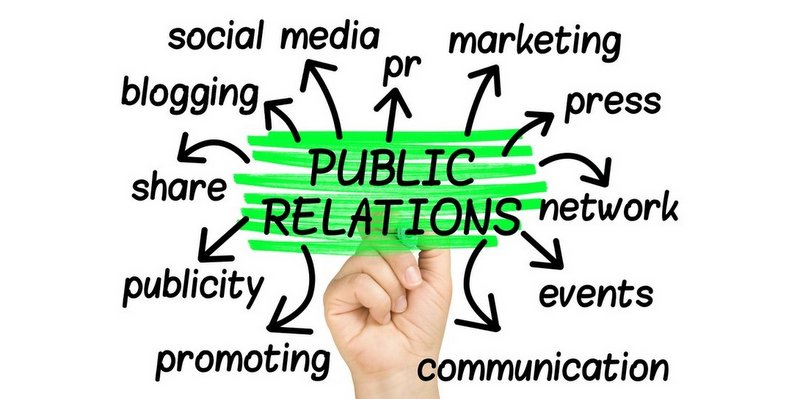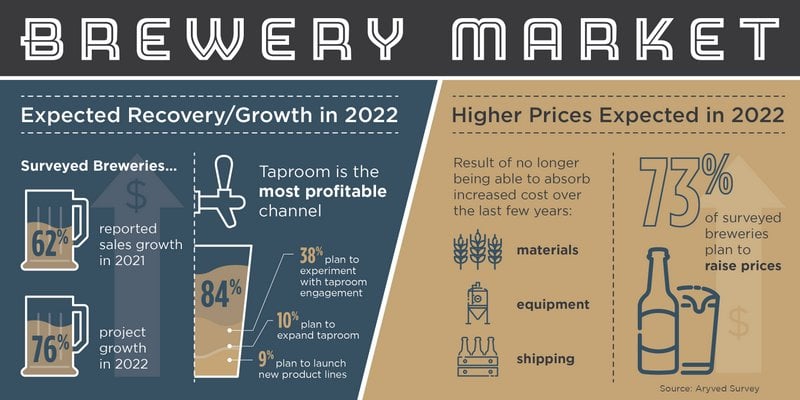
Anyone who shops for groceries, puts gasoline in their car, plugs in their hybrid vehicle or buys a six-pack of their favorite craft beer knows the cost of everything is going up. Talk of, and experience with, inflation is everywhere. At the same time the number of cases of COVID-19 infections in the vast majority of the U.S. are going up as well, although hospitalization rates remain low due, in large part, to a robust vaccination effort.
On the horizon amid the gloom is a silver lining for craft breweries — the industry is projecting unbelievable sales projections after two-years of pandemic-driven hard times. However unbelievable these projections seem, there’s evidence to support them. According to a 2022 Craft Brewing Growth Trends study by Arryved, a POS hospitality management system designed for breweries, bars and restaurants, 59% of craft breweries saw anywhere from 11-to-40% increases in revenue in 2021. That same survey found 76% of craft breweries are projecting growth in 2022.
However, CBB recently reported the Beer Purchasers’ Index (BPI) signaled a contracting demand for beer in the U.S.

To make that silver lining a reality in this environment fraught with significant challenges, brewers need to double-down on their most profitable channel: the taproom. This means sending a signal to craft brewery customers — current and future — that taprooms are safe, offer unique entertainment or socializing opportunities and present a better alternative to higher-priced bars or restaurant chains that cannot offer the same local, beer-aficionado experience as the local taproom.
The most effective way to do so is mounting a public relations campaign that any craft brewery owner or manager can launch with some dedicated time and thoughtful effort. This seemingly free media takes two forms: owned and earned.
Owned Media
Owned media includes a brewery’s website, social media, customer loyalty program and/or customer newsletter. To create a little buzz that helps everyone get a little buzzed, brewers should create messaging that demonstrates a steady drumbeat of interesting and diverse events, new product offerings, specialty menus (when possible), and exclusive tastings for premier customers.
To use social media to its best effect, finding the right frequency of postings as well as using great visuals are paramount. Crowd shots, product shots, behind-the-scenes videos will all help entice those with a passion for great beer. The whole buy local vibe should be maximized, with breweries partnering with, and tagging when appropriate, other local or affiliate businesses. This helps get the brewery on the radar of followers of those other businesses — potentially finding and winning new customers the brewery might not have reached on its own.
Earned Media
The earned media space is more challenging. While it’s free in the sense that breweries aren’t paying to advertise, there is an investment of time and effort that shouldn’t be underestimated.
It starts with identifying those who can get the brewery’s message out to the largest possible audience: print and broadcast media (i.e., local newspapers, television news and radio stations), local and/or regional podcasters that cover small business issues or even beer itself, influencers (don’t knock those TikTok kids; their followers are loyal and a couple thousand or so are old enough to drink), bloggers and even local restaurant critics. Brewers should also consider local residents with large followings on review sites like Yelp. They might be helpful if invited to the taproom for a free tasting, providing them the beer critic experience that might just result in a helpful review for their thousands of followers.
The key to making earned media effective is to contact the right media with the right reach who also speak to the right audience. Admittedly, this is not the easy task it might at first appear to be.
Once the right media are identified, breweries need to get creative. Here’s why: no one cares that the brewery has a great pale ale or snazzy taproom décor. If it smacks of self-promotion, any messaging to earned media targets will fail. To avoid this classic public relations mistake, breweries need to identify a need/interest/benefit of or for the public and work backward to demonstrate how they meet that need, fulfill that interest or provide that benefit for consumers who aren’t their regulars.
Examples include:
- Meeting a need: Guess what’s coming up this winter? Dry January – potentially a craft brewery’s worst nightmare. For savvy craft brewers, jumping on this growing trend by offering creative nonalcoholic brews might be a great way to keep the register ringing as Gen Z and millennials aim to reduce their spending and waistlines while still craving the social aspect meeting friends at the taproom.
- Fulfilling an interest: Sustainable or unexpected ingredients can introduce a craft brewer to an entirely new — and often extremely loyal audiences, especially where sustainability issues are concerned. Almost as important here is the messaging. The more outside the norm, either for a local brewery, local community or the beer industry itself, the more likely it offers a man-bites-dog news quality. In short, if it seems genuinely novel and is designed to attract an audience not already invested in the brewery, it can attract the interest of local news media, influencers and others.
- Providing a benefit: Issues of diversity, equity and inclusion are top of mind for a large segment of today’s consumers that reach beyond race and gender qualifiers. A great example is CBB’s recent coverage of Brewability in Colorado, which recently announced the installation of a vibrational dance floor that promotes inclusion by allowing hearing impaired guests to experience music on the brewery’s dance floor right alongside hearing enabled peers. The brewery even offers a braille menu and servers who can communicate in sign language. While a substantial investment, it is actions like these that grab the attention of the earned media breweries should be targeting to bring in new customers.
Safety & Distinction
With inflation and COVID infections rising, craft brewers have an opportunity to lean into the reality that their costs — in particular those of small craft breweries — may not have risen as quickly as those of the bigger beer brands, potentially making them a slightly more economical alternative. Factor in smaller, more limited menus and less overhead than a full-service restaurant with a large staff, and crafty brewers can make the case that date nights and social occasions are better spent with less spending at the local taproom.
Add in messaging that highlights the taproom’s enhanced hygiene and sanitization practices in the wake of the pandemic, and community brewers are in a strong position to not only maintain, but potentially to increase, their customer base.
Finally, factor in a public relations campaign that highlights some distinctive efforts being made to meet a need, fulfill an interest or provide a benefit to the public, and craft brewers might just make the best of what remains of 2022 and set themselves up to tap into an even better 2023.
Rod Hughes is president of Kimball Hughes Public Relations, which specializes in risk mitigation communications for wineries and breweries.





Leave a Reply
You must be logged in to post a comment.